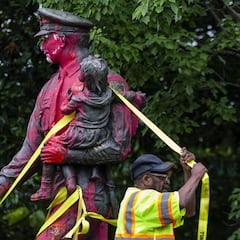Which US states still fly the Confederate flag?
Confederate symbolism has become associated with the far right in the US and is at the forefront of the George Floyd protests, but do any states still fly the flag?

The protests over the death of George Floyd in Minneapolis have reopened a 150-year-old debate in the United States over the symbolism of the Confederate flag and its use by the far-right as an emblem of white supremacist ideology. Statues of Confederate leaders as well as slave traders have become one of the focal points of global outrage over the killing of George Floyd, an unarmed 46-year-old black man who lost his life while being detained over the alleged use of a counterfeit $20 bill. On Wednesday protesters tore down a statue of Confederate President Jefferson Davis in Richmond, Virginia and calls to remove tributes to other figureheads from the Confederate side of the US Civil War have been gathering momentum.
The issue has been a source of simmering tension since the Unite the Right rally in Charlottesville, Virginia in 2017 when white supremacists and far-right elements gathered to oppose the removal of a statue of Confederate General Robert E. Lee. A counter-protester, Heather Heyer, was killed when James Alex Fields Jr., a self-identifying neo-Nazi, drove a car into a crowd of demonstrators.
The display during that rally of Confederate flags led to increased calls for all statues honouring Confederate leaders to be removed. Although the Charlottesville Circuit Court ruled that as a war memorial the statue could not be taken down, it was for six months covered in black tarpaulin and has since been vandalized on numerous occasions.
Virginia governor Ralph Northam announced plans earlier this week to remove the statue of the Confederate general, directing the Department of General Services to remove it "as soon as possible."
Mississippi the only state to fly Confederate flag

At the outset of the civil war 11 states seceded from the Union - Alabama, Arkansas, Florida, Georgia, Louisiana, Mississippi, North Carolina, South Carolina, Tennessee, Virginia and Texas. Missouri and Kentucky are represented on the original Confederate flag as the 12th and 13th stars respectively but had declared neutrality early in the conflict.
The flag that is so divisive in the United States is not in fact the flag of the Confederacy, which flew between 1861 and 1863 and was also known as the “Stars and Bars", but a later version that was adopted after the First Battle of Bull Run in Virginia where it became apparent that the Stars and Bars and the Union’s Stars and Stripes were sufficiently similar to cause confusion on the battlefield.
That prompted Confederate leaders to seek an alternative. What followed was the design now most commonly associated with the Confederacy as a whole, the "battle flag". While mostly identified with Robert E. Lee’s Army of Northern Virginia it was used widely among Confederate armies during the civil war.
However, the adoption of the battle flag and other Confederate symbols by the far right has led to the vast majority of former Confederate states phasing out its use. Only Mississippi now flies the Confederate battle flag in an official capacity – the state has incorporated a blue cross with 13 stars over a red background since 1894.
Georgia adopted a new flag in 2003 based on the first flag of the Confederacy after a public referendum following fierce and prolonged debate over the continued use of the 1956 version that prominently featured the Confederate battle flag.
Continued controversy
President Trump said that his administration "will not even consider" the renaming army bases named after Confederate generals https://t.co/U9qX9VaLsl pic.twitter.com/RrnWQPkrKX
— Forbes (@Forbes) June 10, 2020
The adoption of the Confederate battle flag by the US far right remains contentious despite the ensign never actually being used as an official emblem of the Confederacy but purely as a battlefield device.
Related stories
In the wake of the George Floyd protests the flag is likely to cause further political debate across the US as both states of the former Confederacy and those that supported the Union attempt to find an uncontroversial place for it in US history. President Donald Trump this week announced that he would "not even consider" rebranding US military bases that carry Confederate names.
A YouGov poll conducted in January 2020 shows the issue is far from clear-cut: 41 percent of those surveyed said they associate the battle flag with racism while 34 percent consider it an indelible part of the heritage of the United States.


